Are Cash-Only Practices the Way of the Future?
In recent years, the concept of cash-only practices has intrigued more physicians than ever before (well not EVER before, as most of us can recall our grandparents’ stories of kitchen table procedures when the family doctor made house calls). Turning this concept to reality however takes some serious consideration. Here are some to get you thinking…
- Why do you want a cash-only practice? Is it because you heard of one doctor who lives and practices nowhere near you who made the leap and brags about how much money they make and what an awesome life they have now? Is it because your Medicare Humana patient population is making you wonder if a job at Chik-Fil-A may be more lucrative? Is it because you are sick of proving to “the man” that you provide quality care to patients through audits? Are you tired of paying more to hire and train staff members to verify insurance and chase after “patient responsibility” than you are actually reimbursed? Is your family sick of hearing the woes of the private practitioner every night at dinner?
- Determining if you are in a “compatible demographic” Are there other specialty or primary care cash-pay or concierge model practices near you? This takes a Google search and getting know other local providers who made the leap and could be great referral and networking resources in the future.
- Deciding to go “cold turkey” (which may be in violation of some of your private insurance contracts to treat patients within a certain period of time after you become an out-of-network provider and charge them cash) or do it in phases. This all depends on your payer mix and how reliant you are on even the lowest paying. You may end up deciding during a controlled insurance phase out to keep contracts with a small handful of payers (this may prove more difficult for staff to determine on initial phone calls as more and more plans administered under larger carries come out each year).
- How will this affect staffing levels? For existing practices, with the potential of little or no insurance verifications, eligibility and benefit checks, prior-authorizations, claims submissions/resubmissions, appeals, or balance billing, your administrative and revenue cycle management needs will be much less. Can you find ways to “repurpose” loyal, long term staff that makes sense with your new model? Start up cash pay practices will need to invest what would have been higher payroll dollars into creative, targeted marketing strategies and training small teams of customer service focused staff members.
- Doing it. For new practices, patients will not need to be convinced or converted from the insurance fee-for-service model as from day one they will be prepared to pay in full at time of the service. Established practices may lose a portion of existing patients during the conversion, but at least they have patients to lose.
If you need help determining whether to stay as you are, adapt a hybrid model or take the leap and go completely cash-pay, Pinnacle can help. In any event it is best to first look at cutting out your “low, slow” payers. Several webinars have addressed reports to run and other considerations to make when doing so. These are available in the PEP library.
